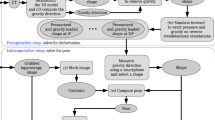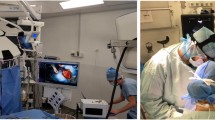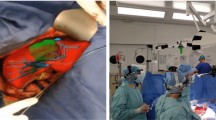Abstract
Purpose
The registration of preoperative 3D images to intra-operative laparoscopic 2D images is one of the main concerns for augmented reality in computer-assisted surgery. For laparoscopic liver surgery, while several algorithms have been proposed, there is neither a public dataset nor a systematic evaluation methodology to quantitatively evaluate registration accuracy.
Method
Our main contribution is to provide such a dataset with an in vivo porcine model. It is used to evaluate a state-of-the-art registration algorithm that is capable of simultaneous registration and soft-body collision reasoning.
Results
The dataset consists of 13 deformed liver states, with corresponding exploration videos and interventional CT acquisitions with 60 small artificial fiducials located on the surface of the liver and distributed within the parenchyma, where a precise registration is crucial for augmented reality. This dataset will be made public. Using this dataset, we show that collision reasoning improves performance of registration for strong deformation and independent lobe motion.
Conclusion
This dataset addresses the lack of public datasets in this field. As an example of use, we present and evaluate a state-of-the-art energy-based approach and a novel extension that handles self-collisions.






Similar content being viewed by others
References
Adagolodjo Y, Trivisonne R, Haouchine N, Cotin S, Courtecuisse H (2017) Silhouette-based pose estimation for deformable organs application to surgical augmented reality. In: Intelligent robots and systems (IROS). IEEE, pp 539–544
Allard J, Cotin S, Faure F, Bensoussan PJ, Poyer F, Duriez C, Delingette H, Grisoni L (2007) Sofa—an open source framework for medical simulation. In: MMVR 15-Medicine meets virtual reality, vol 125. IOP Press, pp 13–18
Amberg B, Romdhani S, Vetter T (2007) Optimal step nonrigid ICP algorithms for surface registration. In: IEEE conference on CVPR’07. IEEE, pp 1–8
Clements LW, Chapman WC, Dawant BM, Galloway RL Jr, Miga MI (2008) Robust surface registration using salient anatomical features for image-guided liver surgery: algorithm and validation. Med Phys 35(6Part1):2528–2540
Collins JA, Weis JA, Heiselman JS, Clements LW, Simpson AL, Jarnagin WR, Miga MI (2017) Improving registration robustness for image-guided liver surgery in a novel human-to-phantom data framework. IEEE Trans Med Imaging 36(7):1502–1510
Collins T, Bartoli A (2015) [POSTER] Realtime shape-from-template: system and applications. In: 2015 IEEE international symposium on ISMAR. IEEE, pp 116–119
Collins T, Bartoli A, Bourdel N, Canis M (2016) Robust, real-time, dense and deformable 3D organ tracking in laparoscopic videos. In: MICCAI. Springer, pp 404–412
Collins T, Chauvet P, Debize C, Pizarro D, Bartoli A, Canis M, Bourdel N (2016) A system for augmented reality guided laparoscopic tumour resection with quantitative ex-vivo user evaluation. In: CARE. Springer, pp 114–126
Cour T, Srinivasan P, Shi J (2006) Balanced graph matching. In: Proceedings of the 19th international conference on neural information processing systems. MIT Press, pp 313–320
Eberly D (2001) Intersection of convex objects: the method of separating axes. Geometric Tools, LLC. http://www.geometrictools.com (1998–2008)
Fabian S, Spinczyk D (2018) Target registration error minimization for minimally invasive interventions involving deformable organs. Comput Med Imaging Graph 65:4–10
Fitzpatrick JM (2009) Fiducial registration error and target registration error are uncorrelated. In: Medical imaging 2009—visualization, image-guided procedures, and modeling, vol 7261. International Society for Optics and Photonics, p 726102
Haouchine N, Dequidt J, Peterlik I, Kerrien E, Berger MO, Cotin S (2013) Image-guided simulation of heterogeneous tissue deformation for augmented reality during hepatic surgery. In: 2013 IEEE international symposium on ISMAR. IEEE
Haouchine N, Roy F, Untereiner L, Cotin S (2016) Using contours as boundary conditions for elastic registration during minimally invasive hepatic surgery. In: 2016 IEEE/RSJ international conference on intelligent robots and systems (IROS). IEEE
Heiselman JS, Collins JA, Clements LW, Weis JA, Simpson AL, Geevarghese SK, Kingham TP, Jarnagin WR, Miga MI (2018) Nonrigid registration for laparoscopic liver surgery using sparse intraoperative data. In: Medical imaging 2018—image-guided procedures, robotic interventions, and modeling, vol 10576. International Society for Optics and Photonics, p 105760D
Kerdok AE, Cotin SM, Ottensmeyer MP, Galea AM, Howe RD, Dawson SL (2003) Truth cube: establishing physical standards for soft tissue simulation. Med Image Anal 7(3):283–291
Klosowski JT, Held M, Mitchell JS, Sowizral H, Zikan K (1998) Efficient collision detection using bounding volume hierarchies of k-DOPs. IEEE TVCG 4:21–36
Koo B, Özgür E, Le Roy B, Buc E, Bartoli A (2017) Deformable registration of a preoperative 3D liver volume to a laparoscopy image using contour and shading cues. In: MICCAI. Springer, pp 326–334
Mahmoud N, Cirauqui I, Hostettler A, Doignon C, Soler L, Marescaux J, Montiel J (2016) Orbslam-based endoscope tracking and 3D reconstruction. In: CARE. Springer, pp 72–83
Modrzejewski R, Collins T, Bartoli A, Hostettler A, Marescaux J (2018) Soft-body registration of pre-operative 3D models to intra-operative RGBD partial body scans. In: MICCAI. Springer, pp 39–46
Plantefeve R, Peterlik I, Haouchine N, Cotin S (2016) Patient-specific biomechanical modeling for guidance during minimally-invasive hepatic surgery. Ann Biomed Eng 44(1):139–153
Rumman NA, Schaerf M, Bechmann D (2015) Collision detection for articulated deformable characters. In: Proceedings of the 8th ACM SIGGRAPH conference on motion in games. ACM, pp 215–220
Suwelack S, Röhl S, Bodenstedt S, Reichard D, Dillmann R, Santos T, Maier-Hein L, Wagner M, Wünscher J, Kenngott H (2014) Physics-based shape matching for intraoperative image guidance. Med Phys 41(11):111901
Thompson S, Schneider C, Bosi M, Gurusamy K, Ourselin S, Davidson B, Hawkes D, Clarkson MJ (2018) In vivo estimation of target registration errors during augmented reality laparoscopic surgery. CARS 13(6):865–874
Thompson S, Totz J, Song Y, Johnsen S, Stoyanov D, Ourselin S, Gurusamy K, Schneider C, Davidson B, Hawkes D (2015) Accuracy validation of an image guided laparoscopy system for liver resection. In: Medical imaging 2015—image-guided procedures, robotic interventions, and modeling, vol 9415. SPIE, p 941509
Zijlmans M, Langø T, Hofstad EF, Van Swol CF, Rethy A (2012) Navigated laparoscopy–liver shift and deformation due to pneumoperitoneum in an animal model. Minim Invasive Ther Allied Technol 21(3):241–248
Author information
Authors and Affiliations
Corresponding author
Ethics declarations
Conflict of interest
The authors declare that they have no conflict of interest.
Ethical approval
All applicable international, national, and institutional guidelines for the care and use of animals were followed. All procedures performed in studies involving animals were in accordance with the ethical standards of the institution at which the studies were conducted.
Additional information
Publisher's Note
Springer Nature remains neutral with regard to jurisdictional claims in published maps and institutional affiliations.
Rights and permissions
About this article
Cite this article
Modrzejewski, R., Collins, T., Seeliger, B. et al. An in vivo porcine dataset and evaluation methodology to measure soft-body laparoscopic liver registration accuracy with an extended algorithm that handles collisions. Int J CARS 14, 1237–1245 (2019). https://doi.org/10.1007/s11548-019-02001-4
Received:
Accepted:
Published:
Issue Date:
DOI: https://doi.org/10.1007/s11548-019-02001-4




